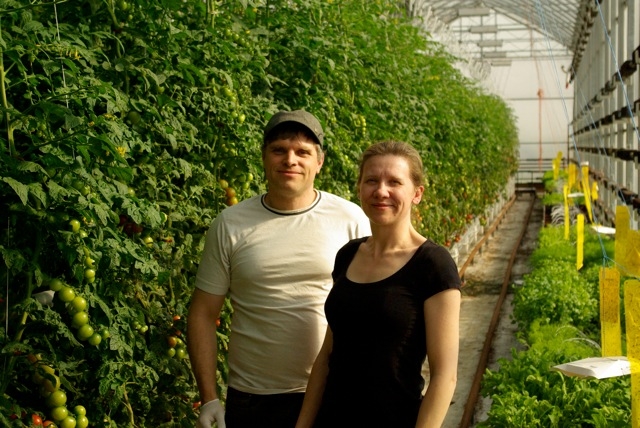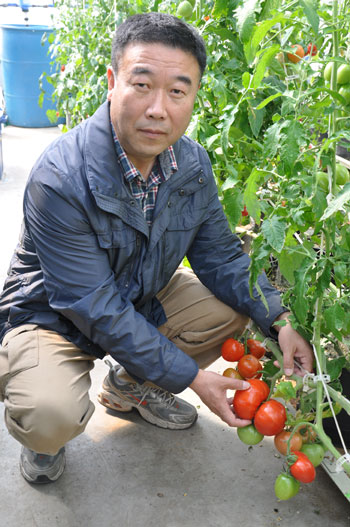Saskatchewan has a well-earned reputation as one of the major agricultural provinces of Canada. When people think of Saskatchewan, they typically think of wide expanses of prairie and fields before anything else. Given our history, it’s only natural that agricultural innovation is easy to find in our province.
Sometimes, however, you have to think outside the field. In the last few years, several new greenhouse-based ventures have sprung up in the Saskatoon area. While winter has halted the growing season in the past, these operations grow food year-round. By showing that you don’t need a field to have a viable agriculture-based business, these companies are changing the way we look at food production.
…………………………………………………………………………………………………………………………………………………….
 One such greenhouse is Jenn’s Garden. Jenn’s Garden set up shop two years ago, with an office at Ideas Inc. in Saskatoon and a greenhouse just outside of Biggar, Saskatchewan. Its products include basil, lettuce, cucumbers and more.
One such greenhouse is Jenn’s Garden. Jenn’s Garden set up shop two years ago, with an office at Ideas Inc. in Saskatoon and a greenhouse just outside of Biggar, Saskatchewan. Its products include basil, lettuce, cucumbers and more.
Jenn’s Garden isn’t just any greenhouse. “We grow hydroponic produce year round, currently for the Saskatchewan market,” says Jennifer Carruthers, company president and CEO. Hydroponics is a method of growing plants without soil. The roots are placed in water that is infused with nutrients, and the plants absorb what they need this way.
Carruthers feels that Jenn’s Garden’s focus on Saskatchewan brings several benefits to its customers. Essentially, people who buy Jenn’s Garden products get to enjoy delicious, fresh produce, all while supporting a local business. “Over 90% of Canadian lettuce is imported from California,” Carruthers says. “There are very few greenhouses on the prairies growing lettuce year round, and no other greenhouse the size of ours doing what we do.”
Jenn’s Garden has had to experiment to see what works best for them. “We do all of our own research,” Carruthers says, “as information has been limited in our province for this type of operation. The intellectual property that we have developed has also given us a growing advantage.”
Jenn’s Garden fresh produce can be purchased in various grocery stores throughout Saskatchewan. Details of where to find Jenn’s products are posted regularly on Facebook.
…………………………………………………………………………………………………………………………………………………….
 Another Saskatchewan-based greenhouse is Floating Gardens, operated by sister and brother team, Rachel and Chris Buhler. Floating Gardens grows a wide variety of produce in a half-acre greenhouse near Osler, Saskatchewan (including kale, spinach, eggplant, herbs, and tomatoes) and supplies numerous restaurants in Saskatoon and area.
Another Saskatchewan-based greenhouse is Floating Gardens, operated by sister and brother team, Rachel and Chris Buhler. Floating Gardens grows a wide variety of produce in a half-acre greenhouse near Osler, Saskatchewan (including kale, spinach, eggplant, herbs, and tomatoes) and supplies numerous restaurants in Saskatoon and area.
Floating Gardens also uses hydroponics, with some plants being grown in only water, while others are grown in ground up coconut shells. To control pests, they use biological agents (beneficial bacteria, fungi and insects), screens and traps, along with sprays allowed under organic agriculture rules.
Chris Buhler cites a familiar statistic for choosing to open shop in Saskatchewan. “We read somewhere that Saskatchewan produces only 5% of its own veggies and fruits,” he says. This was something that Floating Gardens wanted to help change.
Chris and Rachel are originally from Saskatchewan, which also factored in to their decision to open Floating Gardens. “This is our home province. I have a background in greenhouse management; Rachel has a background in plant science. We thought to ourselves, ‘what can we do to both use our skills and come back home?’ and we decided on a greenhouse.”
Buhler also feels that Floating Gardens is unique. “It’s an unusual greenhouse,” Buhler says. “In most greenhouses you grow a large amount of one crop. In our greenhouse, we have various zones and we grow different products in each of those zones. We have a greenhouse that is very flexible, and because of that we can grow more. Our greenhouse was originally designed for experimental studies, rather than only for production purposes.”
Due to this, the Buhler siblings are thinking of taking the greenhouse in a new direction. “We’re exploring more research-based options,” Buhler says. “We see some opportunities in that area in Saskatchewan.”
…………………………………………………………………………………………………………………………………………………….
 Mandi Seed Ltd., is also involved with research in Saskatchewan—specifically, seed production. Mandi supplies hybrid seed with a 90%+ germination rate.
Mandi Seed Ltd., is also involved with research in Saskatchewan—specifically, seed production. Mandi supplies hybrid seed with a 90%+ germination rate.
Mandi is not technically a greenhouse, but does use the services of local greenhouses to conduct research. The company was founded by its President and CEO, Yuancheng Wang, who has a Master’s degree in horticulture and 20 years of breeding and propagation experience. Wang’s life-long goal was to immigrate to Canada from China so that his family could live here and he could expand his business to North America. After visiting Saskatoon in 2012 and discovering that the city had a university with expertise in agriculture and biotechnology, he was convinced that Saskatoon was the best location for Mandi Seed. The company was incorporated in 2014 and has offices in Saskatoon’s North Industrial area.
Wang has been working with Doug Waterer, Associate Professor in the Department of Horticulture University of Saskatchewan (U of S), to learn to adapt his seed growing skills for Canadian conditions. With the U of S research team, Mandi conducted a greenhouse trial last winter and a field trial this past summer, with very positive results.
Mandi Seed’s customers are vegetable producers and growers who serve a number of markets. The varieties that Wang is introducing, including tomato, cucumber and pepper, will be unique to North America. Wang is certain that the company is up for the challenge of demonstrating that Mandi varieties are just as good, if not better, than current options.
…………………………………………………………………………………………………………………………………………………….
Ventures like these challenge how we think about food production. These entrepreneurs look at seemingly insurmountable obstacles—such as Saskatchewan’s formidable winter—and find creative solutions. It’s a good reminder that, every once in a while, we all need to take a step back from what we’re doing and ask ourselves, “is there a better way I could be doing this?” The results might surprise us.